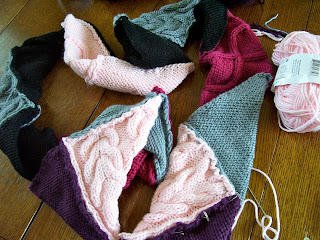
Continuing with my Wilton's saturated colors project results, next are the greens, blues and purples.
Leaf Green/Kelly Green/Moss Green
I let these soak in their dye baths 30 minutes after the last nuke and the leftover dye water in all 3 was still green when I removed them. The Leaf Green is a bit lighter and you can pick up a little more of a yellow cast on the white sample. The Kelly Green doesn't show the blue cast I was expecting, although if the blue needed more time to absorb, that would explain it. The Moss Green is the same depth of color as the Kelly green, with a touch more yellow.
The blues surprised me by not breaking. Since they received the same time to sit in their dye baths as all the other colors, they may not be fully saturated in terms of the blue dye - they may be much deeper if left to sit longer.
Teal/Sky Blue/Royal Blue
It was hard to get an accurate reading of these 3 colors because they all seem to not look quite green enough (compared to the real-life samples), if that makes sense.
Delphinium Blue/Aster Mauve/Violet
On this next group, the Delphinium broke so badly you wouldn't think it's supposed to be a pretty violet-blue. I have no idea where this one color went so wrong, since all of the blues were treated alike and the others did not break. The only explanation I have is that it needs to rest in the dyebath for a much longer time than the other colors and maybe that it needs a lot more vinegar.
With the Aster Mauve I was expecting that ugly 80's muddy pink color, but I got a beautiful pinkish-purple the color of thistles. The violet, which also showed no signs of breaking, is a very dark, very rich, true purple. At this saturation, though, it's almost black.
Tomorrow I will finish up with the neutrals and reveal something very interesting (at least to me).
And, just because she hasn't put in an appearance in a while, here are a couple of totally gratuitous pictures of the cuteness that is Criquette:
























